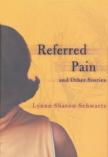Domestic Dread
Lynne Sharon Schwartz is an award-winning author of 14 books of fiction and non-fiction whose principal terrain is the psychological territory of domestic relationshipsthe minefields (or mindfields) of marriages, family relations, couples at the edge and partners in the act of uncoupling or just barely holding together. Under the veneer of the ordinariness of these relationships lurks a kind of exquisite strangeness that emerges from Schwartz’s characteristic combination of obsessive metaphor and seemingly simple, ingeniously layered prose.
Schwartz’s latest collection, Referred Pain and Other Stories, contains 11 short stories and the title novella. While many of these stories explore familiar domestic landscape, several otherseither in experimentation with form or in the adoption of a self-reflexive narrative stanceconcern themselves with writing itself, often in ways that make for fascinating reading but that take the pieces well outside the range of the conventional short story. A short piece like The Word, for example, is more like an essay on how a chance single word, lost to the narrator in the humdrum world of going to the bank, the drugstore, the dry cleaner’s and the copy shop, might have been the seed for an idea for a short story or a novel; but even if recovered after some time, the opportunity will have been irretrievably lost. Later in the collection the reader comes upon a story, By a Dimming Light, to which The Word refers as a story-in-progress based on the phrase writer going blind; the once-successful novelist going blind is bedeviled by the kinds of insecurities general to all writers: Is the graduate student who assists him inventing the fan mail? Are the positive reviews real? Is his prose being edited, perhaps even greatly improved, without his knowledge and consent? Has his talent faded? His real and metaphysical blindness exacerbate these worries.
Other stories in a similar metafictional vein include Twisted Tales, with its subverted fairy tale format to dissect, or, to use Schwartz’s word, anatomize, various character types with modern psychoses, and The Stone Master, a story reminiscent of The Twilight Zone, which becomes more interesting because its real mystery finally lies not in seemingly parallel universes or the mechanism of polished stones as mirrors of the soul, but in the identity of the narrator himself. Of the stories about stories, Intrusions is the most developed. The narrator of this story within a storya teacher of writingelaborates on what may or may not be a fiction initially, changing the I to she as a character emerges from the experience that provides the germ of the narrative (Okay. Someone not me, but scared like me.), editing herself, changing the details, making a fiction with alternate endings or no ending at all. This is a story that should be assigned to beginning writing workshopsnot as a model short story, but as an ingenious analysis of the process.
Several of the stories in this collection combine the themes of domestic relationships and fiction-making, with fictions being the only glue that holds the couples together. Hostages to Fortune appears to explore the rather mundane life of a typical suburban empty-nest couple arguing and worrying over the fates of their two grown special childrenuntil the reader realizes that the Willards have no children, in fact, and that they manipulate the stories of their imaginary offspring as emotional blackmail to keep their relationship with each other going. A more tender version of fictionalizing reality, The Trip to Halawa Valley, uses the guidebook description of an impossible walking tour on the island of Molokai to unite temporarily a divorced couple after the wedding of one of their children.
The most successful stories in this collection all hinge in some way on how the past sometimes makes it impossible for individuals to live fully in their own present. In the title novella, Referred Pain, Schwartz creates a character who can never live up to the standard of suffering set by his parents, Russian Jews who survived the concentration camps and the siege of Leningrad. He embarks on an increasingly surreal course of dental work that he sees as his way to earn his right to live, which destroys his relationships while assuaging his survivor guilt. In Sightings of Loretta it is only after the death of his wife that the protagonist realizes that he lost her years before because of his obsession with the girl he loved when he was six years old, Loretta, who appears sporadically in his adult life. He thought he knew Loretta in ways that he never knew his own wife, but in the end he is left with neither. Similarly, in Francesca a biochemistry professor encounters the child he unknowingly fathered 20-some years earlier and falls in love again with her now-dead mother. Now two women are hurt on my account, he says, and they will never know why.
Most of Schwartz’s characters examine their thoughts and feelings in the manner of the dental patient probing his tongue relentlessly into the hole where his once-sound tooth wasto learn the why of their emptiness, their sorrows. Schwartz delineates these probings with a prose style so attuned to finding just the right word that the reader cannot help but look, while feeling all along that it would be more polite to avert the eyes.
This article also appeared in print, under the headline “Domestic Dread,” in the April 5, 2004, issue.








